TECHNICAL SCIENCES PAPER 2 GRADE 12 QUESTIONS - NSC EXAMS PAST PAPERS AND MEMOS JUNE 2019
Share via Whatsapp Join our WhatsApp Group Join our Telegram GroupTECHNICAL SCIENCES
PAPER 2
GRADE 12
NSC EXAMS
PAST PAPERS AND MEMOS JUNE 2019
INSTRUCTIONS AND INFORMATION
Read the following instructions carefully before answering the questions.
- Write your FULL NAME and SURNAME in the appropriate spaces on the ANSWER SHEET.
- Answer ALL the questions.
- Start each question on a NEW page in the ANSWER BOOK.
- You may use a non-programmable calculator.
- You may use appropriate mathematical instruments.
- Number the answers correctly according to the numbering system used in this question paper.
- Show ALL formulae and substitutions in ALL calculations.
- Round off your FINAL numerical answers to a minimum of TWO decimal places.
- Give brief motivations, discussions et cetera where required.
- A data sheet is attached for your use.
- Write neatly and legibly.
QUESTIONS
QUESTION 1: MULTIPLE-CHOICE QUESTIONS
Various options are provided as possible answers to the following questions. Write down the question number (1.1–1.10), choose the answer and write the letter (A–D) of your choice in the ANSWER BOOK, for example 1.11 A.
1.1 A group of atoms that determine the chemistry of a molecule is called a …
- functional isomer.
- general formula.
- homologous series.
- functional group. (2)
1.2 Butane is used in aerosol spray cans. In which phase is butane at room temperature?
- Liquid
- Plasma
- Gas
- Solid (2)
1.3 C2H6, C2H5OH and CH3COOH are the organic compounds that are investigated by learners to determine their viscosities. Which ONE will be less viscous?
- C2H5OH
- C2H6
- CH3COOH
- C2H5OH and CH3COOH (2)
1.4 Consider the flow diagram below and answer the questions that follow. 
Which of the following correctly represent the reaction conditions for reactions A and B respectively. (2)
Reaction A | Reaction B | |
A | Excess water and a little amount of acid H3PO4 | Catalyst Pd |
B | Insufficient water and H2SO4 | No catalyst |
C | No water and H3PO4 | Catalyst H2SO4 |
D | Excess water and no acid | No catalyst |
1.5 A synthetic material that is derived from organic compounds:
- Polyethene
- Polymerisation
- Plastic
- Polymer (2)
1.6 The bending of light when it passes from one medium to another:
- Reflection
- Diffraction
- Refraction
- Rarefaction (2)
1.7 The diagram below shows the path of light ray, D, hitting a plane mirror. Angles r1, r2, r3 and r4 respectively represent the angles of reflection formed. 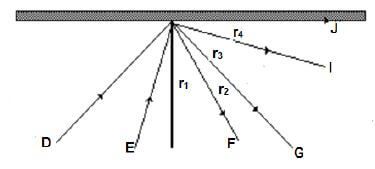
Which of the following is true about the reflected ray and the angle of reflection?
- F is the reflected ray, r1 is the angle of reflection
- G is the reflected ray, r2 is the angle of reflection
- I is the reflected ray, r3 is the angle of reflection
- J is the reflected ray, r4 is the angle of reflection (2)
1.8 Which of the following diagrams represents the phenomenon of total internal reflection? (2)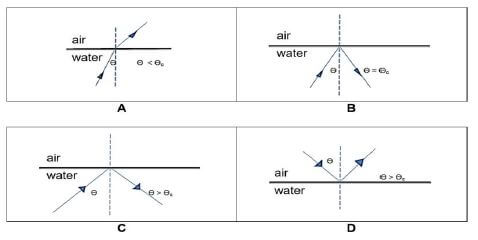
1.9 A light ray travels from air into water. Which ONE of the following combinations, relating to the angle of refraction and angle of incidence, is correct? (2)
Angle of Refraction | Angle of Incidence | |
A | Equal to angle of incidence | Equal to angle of refraction |
B | Less than angle of incidence | Greater than angle of refraction |
C | Greater than angle of incidence | Less than angle of refraction |
D | No change in angle | No change in angle |
1.10 Which ONE of the following electromagnetic waves has the shortest wavelength?
- Radio waves
- Gamma rays
- Infrared rays
- Ultraviolet rays (2) [20]
QUESTION 2 (Start on a new page.)
The letters A–H in the table below represent eight organic compounds from different sets of homologous series. 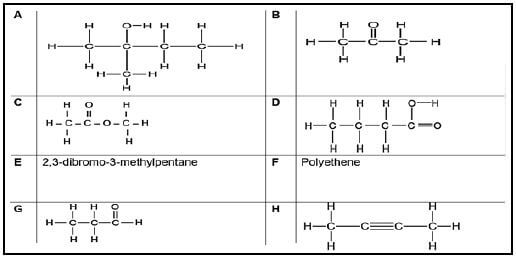
2.1 Define the term homologous series. (2)
2.2 For each of the following compounds, write down the homologous series to which they belong, as well as the name of their functional group:
2.2.1 B (1)
2.2.2 C (1)
2.2.3 G (1)
2.3 Predict the type of reactions these compounds will undergo when they come into contact with bromine. Answer only addition / substitution.
2.3.1 A (1)
2.3.2 H (1)
2.4 Write down letter (s) that represent the following:
2.4.1 Structural isomers (2)
2.4.2 Unsaturated hydrocarbon (1)
2.4.3 Organic compounds with hydrogen bond (2)
2.5 Give the IUPAC name of compound:
2.5.1 A (2)
2.5.2 C (1)
2.6 Write down the structural formula of:
2.6.1 Compound E (3)
2.6.2 Monomer of compound F (2) [20]
QUESTION 3 (Start on a new page.)
Study the graph and answer the questions that follow. 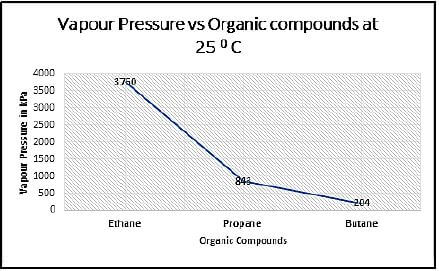
3.1 Why, are these organic compounds referred to as unsaturated hydrocarbons? (1)
3.2 Mention the intermolecular forces found in these organic compounds. (1)
3.3 Define vapour pressure. (2)
3.4 From the graph, identify the following:
3.4.1 The independent variable (1)
3.4.2 The controlled variable (1)
3.5 Describe the trend in the vapour pressures of these compounds. (2)
3.6 Explain the trend mentioned in QUESTION 3.5 above. (3)
3.7 Draw the structural isomer of butane. (2)
3.8 How will the vapour pressure of this isomer compare to that of butane? Answer only HIGHER THAN / LOWER THAN/ EQUAL TO. (1)
3.9 Explain the answer given in QUESTION 3.6 above. (3)
3.10 Which of the compounds from the graph will have the lowest boiling point? (1) [18]
QUESTION 4 (Start on a new page.)
The table below shows the melting points and viscosities of three organic compounds. Study the table very carefully and answer the questions that follow.
COMPOUND | MELTING POINT (°C) | VISCOSITY (c P) |
Butane | 135 | 0,01 |
Butanal | 174 | 0,4 |
Butanol | 183 | 3,0 |
4.1 Butanal and butanol have equal number of carbon atoms but their viscosities are different.
4.1.1 Briefly explain the difference in viscosities. (3)
4.1.2 Mention the type of intermolecular forces these compounds have in common. (1)
4.1.3 Explain why is it important not to work with butanol near open fires. (1)
4.2 Which chemical property of butane and butanol makes it possible for them to be used as fuels? (1)
4.3 Consider the melting points of the compounds in the table, range between 135 °C and 183 °C. Give a reason for this difference in melting points by referring to the type of intermolecular forces present in EACH of these compounds. (3)
4.4 Write down a balanced molecular equation for the complete combustion of butane. (3) [12]
QUESTION 5 (Start on a new page.)
Reactions of pentene are represented in the flow diagram below. 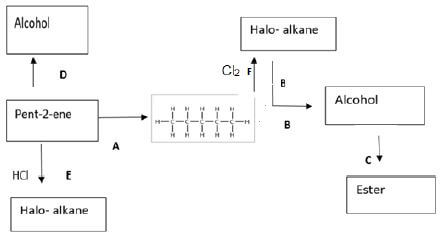
5.1 What type of reaction is represented by each of the following?
5.1.1 A (1)
5.1.2 E (1)
5.2 Both reaction B and D produce alcohol as the product through different types. Explain the difference in these reactions. Refer to SATURATED / UNSATURATED status of hydrocarbons, REACTION TYPE(S) in each reaction and REACTION CONDITIONS required. (3)
5.3 Give the IUPAC name of the alcohol(s) formed in reactions D and B. (1)
5.4 Is the alcohol formed a:
5.4.1 Primary / secondary / tertiary alcohol? (1)
5.4.2 Minor / major product? (1)
5.5 Draw the structural formula of halo-alkane formed in reaction E. (2)
5.6 Use a structural formula to write down a balanced equation between methanoic acid and alcohol formed in reaction B. NOTE: Both alcohol and carboxylic acid must be correctly oriented . (4)
5.7 Give the industrial use of the process represented by reaction A. (1) [15]
QUESTION 6 (Start on a new page.)
6.1 Light is shone on a flat mirror at an angle of 30° as shown in the diagram. Study the diagram and answer the questions that follow. 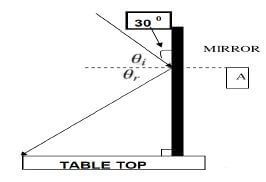
6.1.1 State the law of reflection. (2)
6.1.2 Define the line marked A. (2)
6.1.3 If the light is shone at 30°, what is the magnitude of the angle of incidence θi? (1)
6.1.4 How does the magnitude of the angle of reflection, θr, compare to the angle of incidence? (1)
6.2 A learner placed a container of capsules in front of the flat mirror above and observed the image formed. 
Observation:
The learner went behind the mirror to observe the image but to his surprise he noticed that no image was found behind the mirror. He could only see the image in the mirror.
6.2.1 How does the height of the image compare to that of the container of capsules? (1)
6.2.2 Explain, using the law of reflection, why the learner sees an image in the mirror, instead of seeing an image behind the mirror. (3)
6.2.3 Describe the image formed. (2) [12]
QUESTION 7 (Start on a new page.)
A beam of white light hits a triangular prism, bends and the angle between incident ray and the emergent ray forms. 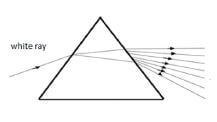
7.1 Define dispersion of light. (2)
7.2
7.2.1 Give a single scientific term for the underlined phrase. (1)
7.2.2 Draw a labelled diagram to show the path of light through the triangular prism. (NOTE: Do not label the angle mentioned in QUESTION 7.2.1 above). (7) 7.3 Give TWO conditions for total internal reflection. (2)
7.4 Most optical equipment like periscopes, telescopes and binoculars use prisms and total internal reflection and not mirrors. 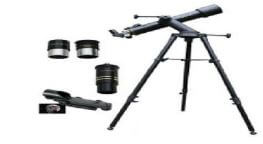
Why is it important to use prisms and total internal reflection in binoculars and periscopes over mirrors? (2) [14]
QUESTION 8 (Start on a new page.)
8.1 A group of Grade 12 learners on a field trip is trying to start a fire by using a lens to focus the sun’s rays onto pieces of paper. They used a certain type of a lens to kindle the fire and their set up is represented in a diagram below. 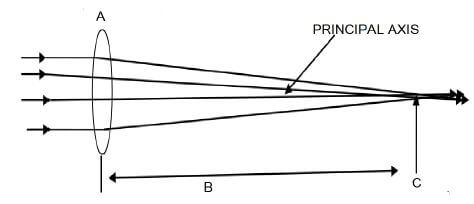
8.1.1 What type of lens is represented by A? (1)
8.1.2 What is the principal axis? (2)
8.1.3 Provide a label for B. (1)
8.1.4 Define the physical quantity represented by letter C. (2)
8.2 Explain how the group of learners should place the lens relative to pieces of paper, in order to ignite it as quickly as possible. (2)
8.3 After setting up the fire, the group of learners cleaned the lens and placed a 4 cm high splinter of wood at a distance of 8 cm from a lens with a focal point of 6 cm.
8.3.1 Make use of a scale drawing to determine the position of the image. (4)
8.3.2 Identify THREE properties of the image formed. (3) [15]
QUESTION 9 (Start on a new page.)
9.1 Electromagnetic waves (are waves that) are created as a result of changing magnetic and electric fields which are mutually perpendicular to each other and to the direction of propagation. These waves form an electromagnetic spectrum in which each wave has an important use. Valuable items such as bank notes and passports can be security marked using fluorescent ink. The ink can only be seen in ultraviolet radiation and is used to differentiate between genuine and counterfeit notes or passports. 
Name the type of electromagnetic radiation that is used in:
9.1.1 Radar and communication systems (1)
9.1.2 The detection of radioactive tracers (1)
9.1.3 Special lamps by fast-food restaurants to heat food (1)
9.2 Briefly explain how the South African Police Service (SAPS) uses ultraviolet radiation in forensic science to investigate crime scenes. (3)
9.3 The security officer at the airport is using a certain type of electromagnetic wave to detect hidden weapons and other dangerous items in passengers’ luggage to ensure the safety of other passengers. 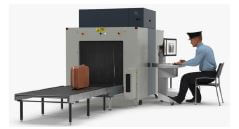
9.3.1 Name the type of electromagnetic waves used at the airport. (1)
9.3.2 Compare the wavelength, frequency and penetrating ability of the waves mentioned in QUESTION 9.3.1, to that of microwaves as well as those waves mentioned in QUESTION 9.1.2 above. (3)
9.4 The table below shows different energies that were measured at different wavelengths for an electromagnetic wave. Study the table and answer the questions that follow.
E (x 10 -19 J) | λ (x 10 -9 m) | f (Hz) |
2,35 | 857 | |
2,45 | 833 | |
2,55 | 789 | |
2,65 | 752 | |
2,75 | 723 | |
2,85 | 699 |
9.4.1 Complete the table by calculating all values of frequency f. (2)
9.4.2 Refer to the table to describe the trend between the values of frequency, f, calculated in QUESTION 9.4.1 and the wavelength above. (2)
9.4.3 Plot the points of E vs f. Draw the line of best fit on the graph. (3)
9.4.4 From the graph drawn, give a single term for the ratio E/f. (1)
9.5 Photons of an electromagnetic wave have an energy of 2,83 x 10-25 J. Calculate:
9.5.1 The frequency of the wave (3)
9.5.2 The wavelength of the wave (3) [24]
TOTAL: 150
NATIONAL SENIOR CERTIFICATE
DATA FOR TECHNICAL SCIENCES GRADE 12
PAPER 2
TABLE 1: PHYSICAL CONSTANTS
NAME | SYMBOL | VALUE |
Planck’s constant | h | 6,63 × 10-34 J·s |
Speed of light | C | 3 × 108 m·s-1 |
TABLE 2: FORMULAE
WAVES, SOUND AND LIGHT | |
Speed | c=fλ |
Energy | E=hf Or E = hc |